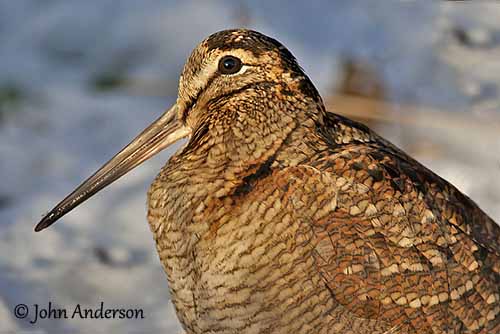
Fr: Bécasse des bois
Ang: Eurasian Woodcock
All: Waldschnepfe
Esp: Chocha Perdiz
Ita: Beccaccia eurasiatica
Nd: Houtsnip
Sd: Morkulla
Photographer:
John Anderson
John Anderson Photo Galleries
Text by Nicole Bouglouan
Sources:
HANDBOOK OF THE BIRDS OF THE WORLD Vol 3 by Josep del Hoyo-Andrew Elliott-Jordi Sargatal - Lynx Edicions - ISBN : 8487334202
SHOREBIRDS by Peter Hayman, John Marchant and Tony Prater – Christopher Helm – 1986 – ISBN: 0747014035
THE HANDBOOK OF BIRD IDENTIFICATION FOR EUROPE AND THE WESTERN PALEARCTIC by Mark Beaman, Steve Madge - C. Helm - ISBN: 0713639601
L’ENCYCLOPEDIE MONDIALE DES OISEAUX - Dr Christopher M. Perrins - BORDAS - ISBN: 2040185607
ENCYCLOPEDIE DES OISEAUX DE FRANCE ET D’EUROPE – de Peter Hayman et Rob Hume - Flammarion – ISBN : 2082009920
THE COMPLETE BOOK OF BRITISH BIRDS – Written by “Royal Society for the Protection of Birds” experts - Préface de Magnus Magnusson - Michael Cady- Rob Hume Editors - ISBN: 0749509112
Wikipedia, the free encyclopaedia
Game & Wildlife – Conservation Trust
Eurasian Woodcock
Scolopax rusticola
Charadriiformes Order – Scolopacidae Family
INTRODUCTION:
The Eurasian Woodcock is included in the genus Scolopax in the subfamily Scolopacinae, with some other species, and between them the American Woodcock (Scolopax minor) which is very similar but smaller.
This bird is often difficult to see with its cryptic plumage making it almost invisible among the vegetation. However, it usually ventures at forest edge at dusk because it is more active at night, between dusk and dawn.
The Eurasian Woodcock differs from other Scolopacidae species by living in the woods where the plumage provides the bird an excellent camouflage while walking on the leaf litter.
It performs aerial displays at dawn and dusk during the breeding season, while uttering peculiar sounds.
The Eurasian Woodcock is a gamebird in many countries, but speed and flight pattern make it a very challenging shot for hunters.
This species is mentioned in folklore and legends in the United Kingdom, and has been the subject of postage stamps from numerous countries.

DESCRIPTION OF THE BIRD:
Biometrics:
Length: 33-35 cm
Wingspan: 56-60 cm
Weight: 144-420 g
The Eurasian Woodcock is a plump woodland bird. Its plumage is heavily vermiculated and barred brown. It has broad wings and shows owl-like appearance in flight.
The upperparts are rufous-brown and reddish, whereas the underparts are paler, mostly buffy-white and narrowly barred dark brown.
On the head, there are 3-4 broad black bars on the crown. We can see dark malar and eye stripes. Chin and throat are white.
The long bill is flesh-coloured with dark tip. The large brown eyes are located high on the head sides, giving the bird 360-degree monocular vision. There is a broad, white crescent below, and narrower above the eye. Legs and feet may vary from grey to pinkish.
Male and female have similar plumage, but the male is much larger than the female. No seasonal variation in plumage.
The juvenile resembles adult with more spotted forehead.
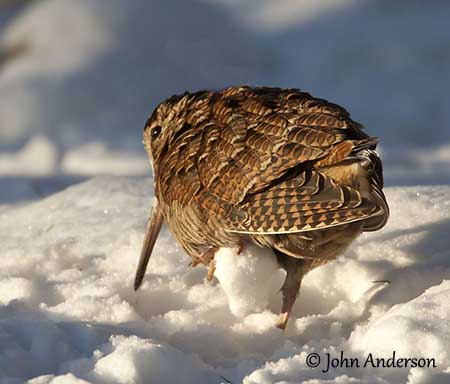
RANGE:
The Eurasian Woodcock breeds in Europe, but more than 90% of the continent’s population breeds in Russia and Fennoscandia. The breeding range extends to the Mediterranean Sea and the Canary Islands and from W Europe to Russia.
Populations from NW and S Europe are usually sedentary, but northern and Asian birds migrate southwards, respectively to southern Europe and the Indian Subcontinent. They are resident in W Europe and on Atlantic Islands such as Azores, Madeira and Canary Islands.
HABITAT:
The Eurasian Woodcock usually avoids warm and dry habitats. It breeds in moist forests and extensive broadleaved, mixed or coniferous woodlands with mosaic habitats including undergrowth, open areas, damp patches and streams where it can find its food.
Outside the breeding season, it occurs in the same type of habitats during the day and also in young conifer plantations.
On passage, it may occur in coastal scrub. The weakened birds are much affected by too cold weather and can be found even in urban gardens.
At night, they gather for roosting and feeding in grasslands.
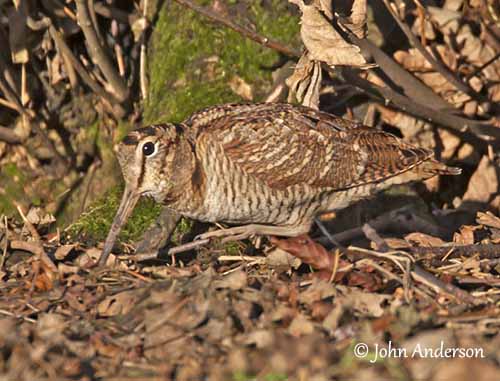
CALLS AND SONGS: SOUNDS BY XENO-CANTO
The Eurasian Woodcock utters a strange, weak, high-pitched “pitz” or “tswik” interspersed with low, deep, guttural “aurk-aurk-aurk”. These sounds are given during the display flight called “roding”, and the sequence is constantly repeated.
When flushed, it is usually silent, but it may produce a low “scaap” recalling that of the Common Snipe, and sometimes repeated quickly.
BEHAVIOUR IN THE WILD:
The Eurasian Woodcock feeds primarily on earthworms found both in fields and woodlands. It also takes spiders, harvestmen (Pholcidae), beetles, insects and their larvae, crustaceans and slugs. It consumes plant matter too, including seeds, fruits, grain, roots and blades of several species of grasses.
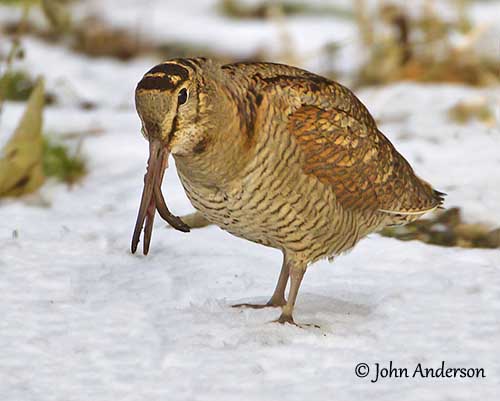
It feeds by probing in damp, soft soil with its long bill, but it also pecks at the surface and under the leaf litter. It may use foot-trembling to disturb invertebrates hidden under the dead leaves. It is almost always solitary.
Outside the breeding season, it feeds mostly at night when earthworms are abundant in pastures and meadows.
During the day, the Eurasian Woodcock roosts in fields with close woodland, and feeds in moist forests with humus where it finds numerous earthworms. It favours areas with dense vegetal cover for better protection.
During the breeding season, the male performs aerial displays called “roding”. It quarters its territory at dusk and dawn by flying with jerky wingbeats. It flies above the treetops while uttering its peculiar song. It flies slowly while searching for receptive females on the ground.
After mating, the male may remain with the female until the laying is done, but it does not take part in incubation and chick rearing. It is polygynous.
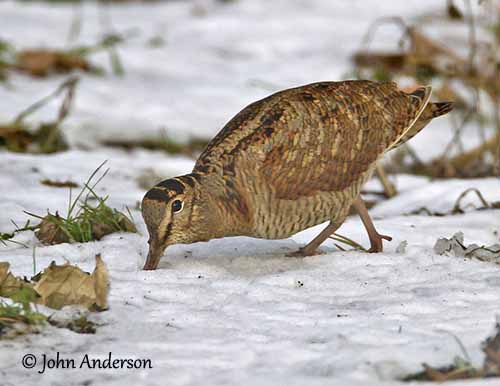
The Eurasian Woodcock female is known for carrying her chicks in flight, by holding them between legs and belly when they are threatened. Several trips are needed to move all the chicks to safety. However, this behaviour has not been observed and is still debatable. It is probably unusual and rare, and only performed over short distances.
The Eurasian Woodcock is mostly migratory. The spring migration starts in February and the birds reach their breeding grounds between March and May. Usually, the females migrate first. Young birds and adults return to their usual nesting sites. They migrate at night.
When flushed, the Eurasian Woodcock rises suddenly and silently, or only produces a swishing sound. It performs a zigzagging flight away through the trees, out of the sight of the intruder.
The usual flight action is relatively slow compared to other snipes.
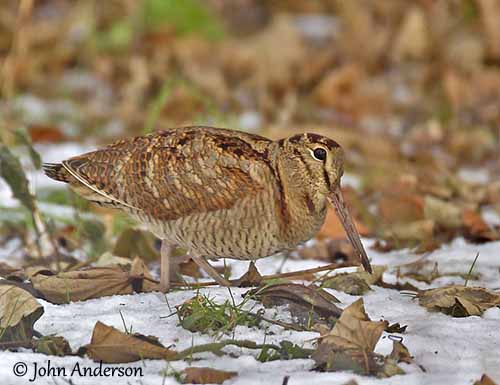
REPRODUCTION OF THIS SPECIES:
The laying takes place between early March and mid-April. The Eurasian Woodcock’s nest is a shallow depression in the ground, concealed among the vegetation in woodland or tall heather. The nest is lined with dead leaves or other plant material.
The female lays 2-6 eggs, usually 4 creamy-white eggs with brown spots. The female incubates alone during 21-24 days. At hatching, the chicks have pale pinkish-buff down above, with conspicuous dark spots and bands. They are precocial and leave the nest immediately. They fledge between 15 and 20 days after hatching, but they are able to perform short flight at 10 days.
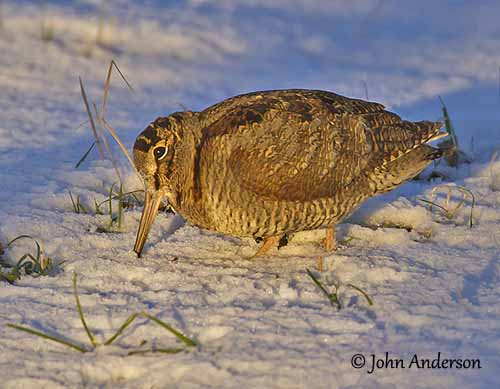
PROTECTION / THREATS / STATUS:
The Eurasian Woodcock has wide range and the population is stable. This species is affected by heavy fragmentation of woodlands, and loss of permanent grasslands and hedges for agriculture expansion. It is also widely hunted, and the largest numbers are taken in France, Italy, United Kingdom and Spain.
In recent years, several birds with shorter bills and malformations have been found, maybe due to the use of pesticides in cultivated areas.
But currently, the Eurasian Woodcock is evaluated as Least Concern, with a global population estimated to number 15/16,000,000 individuals (2002).
